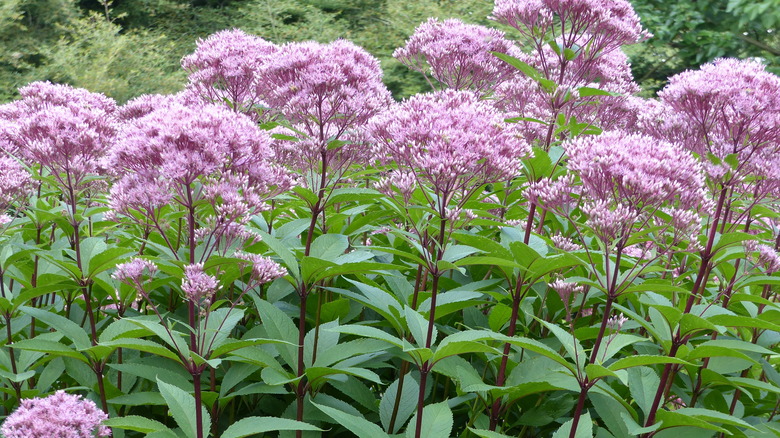Believed to be named for a 17th century Native American herbalist, Joe Pye weed is a colorful, low-maintenance flower. Dave Forehand, vice president of gardens for the Dallas Arboretum and Botanical Garden, recommends this easily-grown pollinator plant with its abundant purple flowers. “It’s a native plant and can grow from Canada to Florida,” he says. Plus, “it attracts butterflies and hummingbirds and can grow well in sun to partial shade.” The pink-purple flowers resemble swamp milkweed, but Joe Pye weed is taller and grows more vigorously.
Swamp milkweed (Asclepias incarnata) is a pink-flowering version of asclepias, the orange-flowering plant known as butterfly weed or milkweed. But where swamp milkweed only grows to a mature height of three to five feet, Joe Pye weed can grow up to eight feet tall. Both plants bloom in the summer and have a long flowering period. Both produce attractive pink flowers, with Joe Pye weed having flowers that tend towards a light rosy purple or mauve color. With its nectar-rich flowers through the long growing season, Joe Pye weed is a popular choice for pollinator gardens.
Another difference between the two plants is that swamp milkweed is slightly more cold hardy and heat tolerant than Joe Pye weed. Swamp milkweed grows best within a 3-6 USDA growing zone, while Joe Pye weed prefers a 4-9 USDA growing zone. When Joe Pye weed is introduced into favorable conditions, it reseeds and spreads readily, and can become somewhat invasive in the garden.
Joe Pye weed in the garden

Joe Pye weed contains a number of species, with the three most common being hollow Joe Pye weed (Eupatorium fistulosa), spotted Joe Pye weed (Eupatorium maculatum), and sweet Joe Pye weed (Eupatorium purpureum). Note that the Eupatorium genus name is sometimes replaced with Eutrochium. All three varieties are tolerant of many soil conditions, and do best in full or partial sun. Sweet Joe Pye weed tolerates somewhat shadier and drier conditions, while hollow and spotted varieties tend to prefer moist, sunny locations.
Because it can get up to eight feet tall, plant it at the rear of the border or in front of a fence. You can cut the young plants back in spring to prevent them getting too tall. This plant likes moist soil and grows well near a downspout or rain gutter. If you have a large property, consider planting Joe Pye weed in a pollinator meadow setting. Joe Pye weed attracts many beneficial pollinators such as various types of bees, including honeybees, bumble bees, leafcutter bees and cuckoo bees. It provides food for butterflies, including monarchs, swallowtails, and skippers. Joe Pye weed is also a plant host for the caterpillars of various moth species.
Because of its height, birds enjoy perching on its flat flower heads, and eating the seeds once the late season seedheads form. These seedheads provide nutritious snacking for birds and can last well into the winter months. They attract a variety of birds including American goldfinches, Carolina wrens, dark-eyed juncos, and tufted titmice.
Caring for Joe Pye weed
Although Joe Pye weed is fairly low-maintenance during the growing season, there are a few tips for managing it over the long term. Planting in a well-draining soil makes it easier to divide than growing it in clay soil.
The plant tends to spread in two ways: by reseeding itself (via wind or wildlife), or by the plant spreading outwards from a central clump. Some gardeners welcome the reseeded plants to help fill out a pollinator garden or meadow. If you don’t want it to reseed, you can cut back the seedheads before the seeds get dry enough to disperse, but this prevents birds from eating the seeds: one of the joys of having Joe Pye weed in your yard! So a better way to control it is to just pluck the new young plants if they spring up in places where you don’t want them.
Once the clumps of your Joe Pye weed get large, the roots can get quite thick and may get matted together, making it difficult to dig out or divide the plants. Therefore, it’s best not to let the clumps get bigger than a foot across before dividing them.
